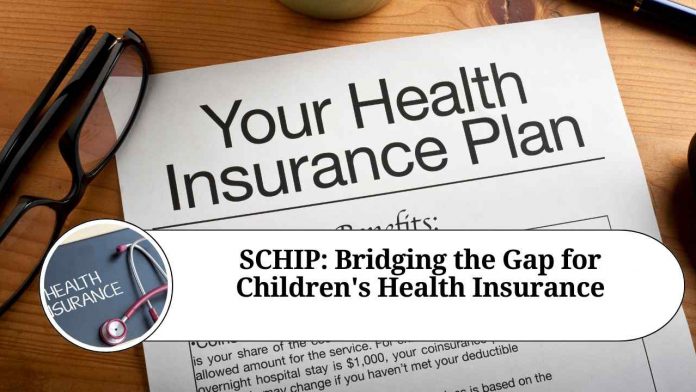Introduction
Access to quality healthcare is a fundamental right that should be available to every individual, regardless of their socioeconomic status. However, for many low-income families in the United States, ensuring affordable health coverage for their children can be a daunting task. Fortunately, the State Children’s Health Insurance Program (SCHIP) plays a vital role in bridging this gap and providing much-needed support to millions of children across the nation. In this blog, we will explore the SCHIP program, its significance, and the impact it has on the lives of children and families.
Understanding SCHIP:
SCHIP, also known as the State Supplemental Health Insurance Program, was established in 1997 as a joint federal and state initiative to address the growing issue of uninsured children. It aims to provide comprehensive health coverage to children from low-income families who do not qualify for Medicaid but still cannot afford private health insurance.
The program operates through a partnership between the federal government and individual states. While the federal government sets basic guidelines and funding, each state has the flexibility to design its own SCHIP program based on its unique needs and demographics. This flexibility allows states to tailor the program to best serve their population.
Key Features and Benefits:
- Affordable Coverage: SCHIP offers affordable health coverage options for children, typically with low premiums and copayments. This ensures that families who are financially struggling can still access essential medical services without worrying about exorbitant costs.
- Comprehensive Services: The program provides a comprehensive range of services, including doctor visits, immunizations, emergency care, prescription medications, dental care, and mental health services. By covering these essential healthcare needs, SCHIP helps children receive the care they require for their overall well-being.
- Preventive Care: SCHIP places a strong emphasis on preventive care. Regular check-ups, immunizations, and screenings are covered, enabling early detection and intervention for potential health issues. By focusing on prevention, the program helps to mitigate long-term health problems and reduce healthcare costs in the future.
- Continuity of Coverage: SCHIP ensures that eligible children can maintain their coverage even if their family’s income fluctuates. This stability is crucial for children’s health, as it prevents interruptions in care and allows for ongoing management of chronic conditions.
- State Flexibility: As mentioned earlier, SCHIP allows each state to design its own program, tailoring it to the specific needs of its population. This flexibility enables states to address unique healthcare challenges and implement innovative solutions that best serve their communities.
Impact and Success of SCHIP:
Since its inception, SCHIP has played a pivotal role in reducing the number of uninsured children in the United States. According to the Centers for Medicare & Medicaid Services (CMS), as of 2020, the program provided coverage to approximately 5.8 million children nationwide. This substantial coverage has had a profound impact on children’s health outcomes, improving access to necessary medical care and promoting overall well-being.
Studies have shown that children enrolled in SCHIP experience better health outcomes, including increased access to primary care, reduced hospitalizations, and improved preventive care utilization. By addressing health disparities and ensuring access to comprehensive healthcare services, SCHIP has contributed to narrowing the gap in children’s health between different socioeconomic groups.
Conclusion
SCHIP, the State Children’s Health Insurance Program, has been instrumental in providing affordable and comprehensive health coverage to millions of children in the United States. By offering a safety net for low-income families who do not qualify for Medicaid, SCHIP plays a crucial role in bridging the gap and ensuring that children receive the healthcare they need for a healthy future.
Read more useful content:
Frequently Asked Questions (FAQs)
Q1: What is SCHIP?
A1: SCHIP stands for State Children’s Health Insurance Program. It is a joint federal and state initiative established in 1997 to provide health insurance coverage to children from low-income families who do not qualify for Medicaid but cannot afford private insurance.
Q2: Who is eligible for SCHIP?
A2: Eligibility for SCHIP varies by state, as each state has its own program guidelines. Generally, children up to the age of 19 from families with incomes above the Medicaid eligibility level but below a certain threshold set by the state may qualify for SCHIP.
Q3: How does SCHIP work?
A3: SCHIP operates through a partnership between the federal government and individual states. The federal government provides funding and sets basic guidelines, while states have the flexibility to design their own SCHIP programs based on their specific needs and demographics. States receive federal funds based on their enrollment and costs.
Q4: What services does SCHIP cover?
A4: SCHIP provides a comprehensive range of services, including doctor visits, immunizations, hospital care, emergency care, prescription medications, dental care, vision care, and mental health services. Each state’s program may have variations in coverage, so it is important to check with your state’s SCHIP program for specific details.
Q5: How much does SCHIP cost?
A5: SCHIP aims to provide affordable coverage for low-income families. The cost of SCHIP varies by state, but it generally has low premiums and copayments. The exact costs depend on factors such as family income and the specific SCHIP program in your state.
Q6: Can children already enrolled in Medicaid qualify for SCHIP?
A6: No, children who are eligible for Medicaid are not eligible for SCHIP. SCHIP specifically targets children from families who earn too much to qualify for Medicaid but still have limited financial resources to afford private insurance.
Q7: Can children with pre-existing conditions enroll in SCHIP?
A7: Yes, SCHIP covers children with pre-existing conditions. One of the program’s goals is to ensure that all eligible children, regardless of their health status, have access to necessary healthcare services.
Q8: Is SCHIP available in all states?
A8: Yes, SCHIP is available in all 50 states, the District of Columbia, and U.S. territories. However, the program may have different names in some states, such as “CHIP” (Children’s Health Insurance Program).
Q9: Can families switch between Medicaid and SCHIP?
A9: Yes, families’ eligibility for Medicaid and SCHIP can change based on fluctuations in income. If a family’s income decreases and falls below the Medicaid eligibility threshold, they may transition from SCHIP to Medicaid.
Q10: How can I apply for SCHIP?
A10: To apply for SCHIP, you can contact your state’s SCHIP program directly or visit the InsureKidsNow website (insurekidsnow.gov). They provide information on eligibility, application processes, and enrollment assistance for SCHIP and Medicaid programs in each state.




















